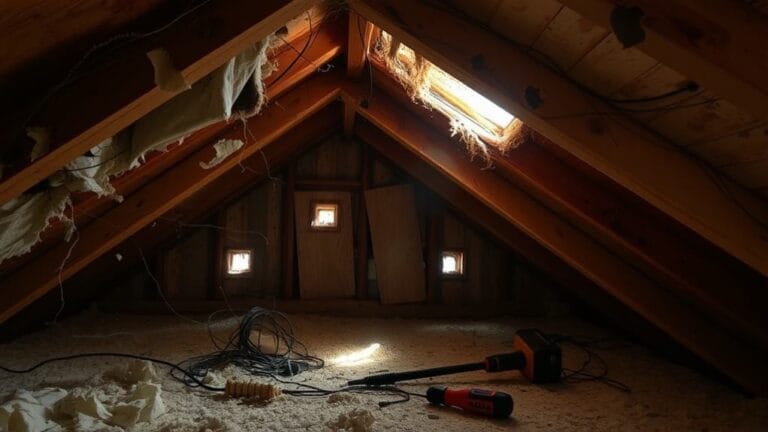Found a raccoon camping out in your engine? Let's get that furry squatter out safely. First, kill the engine and remove your keys – duh. Next, check for signs like droppings or scratching sounds to confirm your unwanted tenant. Create an exit strategy by placing ammonia-soaked rags near the engine and gently tapping the hood. If Rocky's being stubborn, try honking the horn or letting the engine idle to make things uncomfortable. Finally, prevent future engine invasions by keeping food away and banging on the hood before starting up. But wait – there's more to keeping these masked mechanics away from your ride.
Initial Safety Precautions
Table of Contents
Engine compartments provide tempting shelter for raccoons, but removing them safely requires careful preparation. The pests are often drawn to warm engines and can be deterred with natural repellent sprays around entry points.
Let me walk you through the initial safety precautions that'll keep you from turning this wildlife encounter into a disaster movie.
First things first – and yes, this should be obvious – kill that engine and remove your keys. Unless you want to star in "Raccoon vs. Machine: The Messy Edition."
Here's what you need to do to keep your car (and yourself) raccoon-drama-free:
- Park in a quiet, ventilated area away from traffic
- Put on thick gloves – those health risks from bites and scratches are no joke
- Resist the urge to play wildlife warrior by reaching in there
*Pro tip: Your best move is keeping a safe distance and making noise to encourage them to leave. Still no luck? Animal Services is just a phone call away.*
Assessing The Situation
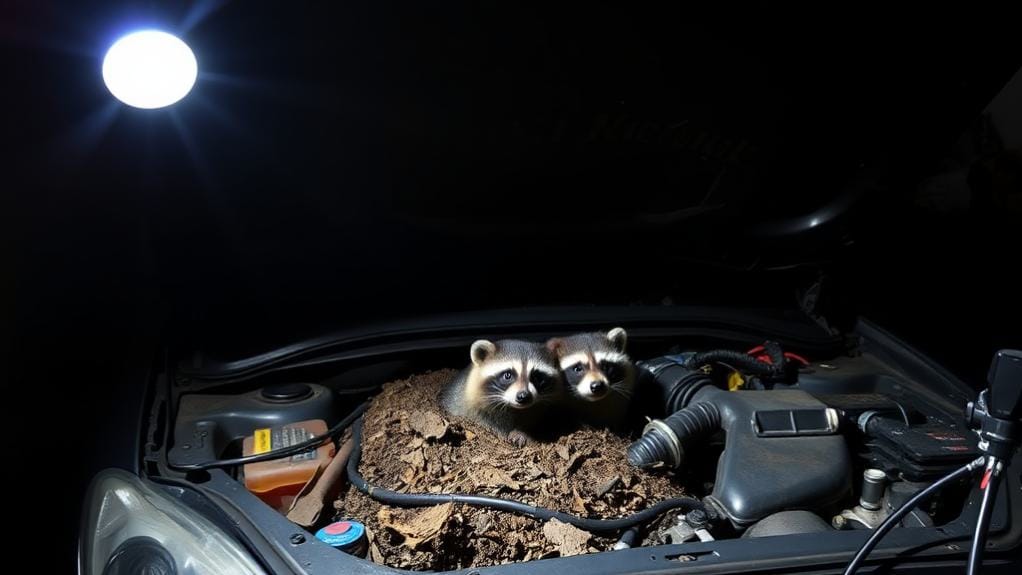
Every successful raccoon removal starts with proper reconnaissance of your vehicle and its surroundings. Those sneaky bandits leave telltale signs – you just need to know where to look.
Like their urban adaptability on rooftops, raccoons are equally skilled at finding cozy spots in engines.
Before you even think about starting that engine, check for:
- Droppings or paw prints near the engine compartment (yes, it's gross but necessary)
- Scratching or rustling sounds (they're not exactly quiet tenants)
- Food sources lying around your car (that forgotten burger wrapper? Big mistake)
- Signs of nesting material like shredded paper or leaves
Pro Tip: Raccoons are night owls, so your morning commute is prime time for unexpected engine guests.
Take a good look at nearby trees and bushes too.
These critters love having a backup hideout when you interrupt their cozy engine nap.
Creating An Exit Path
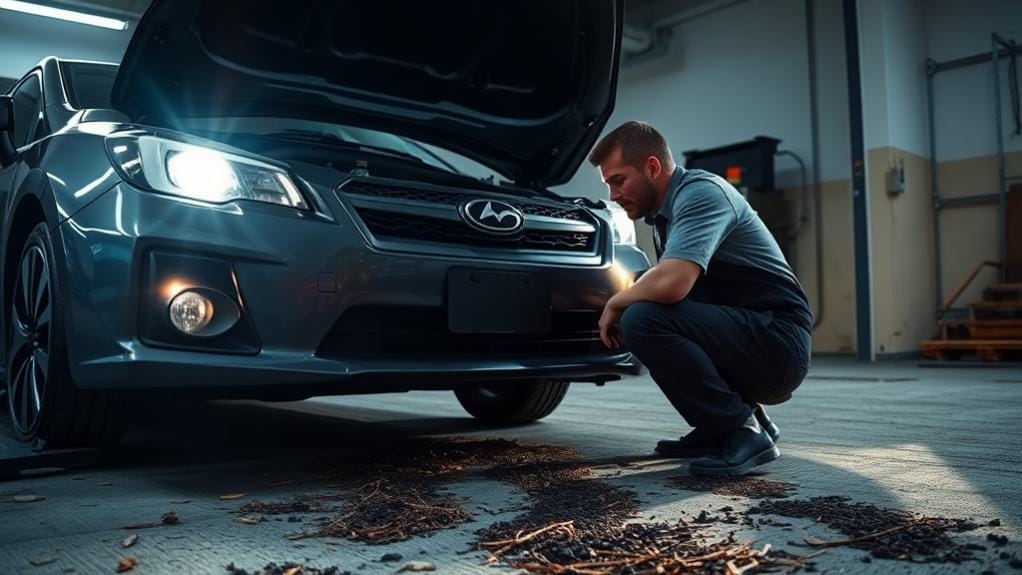
Three essential steps make up a safe exit strategy when you've got a raccoon camping in your engine.
First, you'll want to KEEP things calm – no sudden moves or loud noises that'll send your unwanted tenant deeper into their cozy car engine hideout.
Consider placing some ammonia-soaked rags near but not inside the engine compartment, as raccoons hate this scent.
Start by giving the hood some gentle knocks. Yeah, like you're politely asking your furry friend to leave their five-star accommodation.
Pop the hood open to create an obvious escape route. Trust me, they'll feel safe when they can sense the cool air and see freedom ahead.
Pro tip: Start your engine and let it idle for a minute. Those vibrations are like a gentle eviction notice – just enough to make your raccoon rethink their living situation without sending them into panic mode.
Monitor the situation quietly until your visitor makes their exit.
Removal Techniques
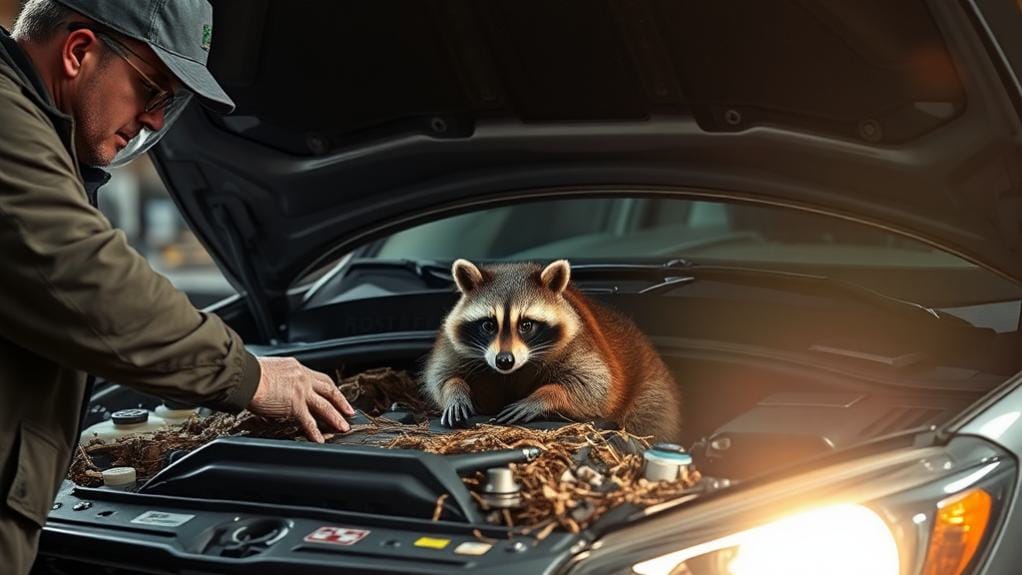
When gentle persuasion falls short, you'll need to step up your removal game with proven techniques that keep both you and your engine-dwelling friend safe. Let's break down your best options for getting that stubborn raccoon to pack its bags.
| Method | Effectiveness | Safety Rating |
|---|---|---|
| Horn Honking | High | Very Safe |
| Irish Spring | Medium | Very Safe |
| Live Traps | High | Safe |
| Noise Making | Medium | Very Safe |
| Food Lures | High | Safe |
*Pro Tip: Never use repellents containing poison – unless you want a dead raccoon in your engine and a whole lot of explaining to do.*
Start with noise techniques and work your way up to food-baited traps. I've found that combining methods works best – try placing Irish Spring soap near your live trap while making noise. Remember to check thoroughly for babies once your unwanted mechanic vacates!
Prevention Methods
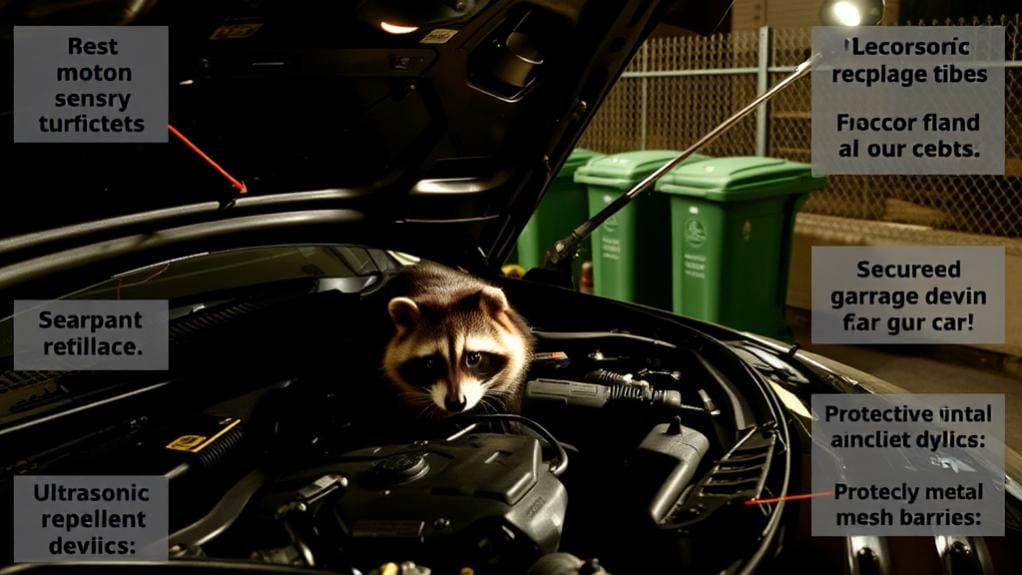
Now that you know how to remove a raccoon from your engine, let's focus on keeping these clever critters out in the first place.
Trust me – you'll want to take steps before these furry troublemakers make your car their cozy winter retreat. Consider using natural hot pepper sprays around your vehicle for added protection.
Here's what works:
- Pop that hood when you park at night. Raccoons hate exposed spaces – they're not exactly fans of the spotlight.
- Use repellents around your parking area. Those ultrasonic devices might seem fancy but they actually work.
- Check your parking spot daily for raccoon "calling cards" (yeah, I mean poop) and footprints.
- Keep food and trash far from your car. Don't turn your driveway into a raccoon buffet!
*Pro tip: Bang on your hood before starting your car. It's like giving unwanted guests a loud wake-up call.*
Frequently Asked Questions
How to Keep Raccoons Out of Car Engine?
I keep my hood open at night, knock on wheels before starting, remove food sources around my car, use ultrasonic repellents, and check regularly for signs of raccoon activity in my engine compartment.
Can Running Over a Raccoon Damage Your Car?
Yes, I can tell you that running over a raccoon can seriously damage your car's bumper, grille, headlights, radiator, and undercarriage. It's best to safely avoid hitting them whenever possible.
How to Get a Possum Out of a Car Engine?
As I peek under my car's hood at the startled possum, I'd suggest you first park in a quiet spot, then gently tap the hood or honk. If it won't leave, try baiting with food or call Animal Services.
How to Keep Rodents From Car Engine?
I keep rodents out of my car engine by leaving the hood up at night, using capsaicin tape on wires, applying rodent repellents, and storing my vehicle in a clean garage without food debris.
Last Word
Let's be real – dealing with a raccoon in your engine isn't anyone's idea of a good time. I've walked you through the battle plan, but remember: prevention beats playing wildlife removal expert at 6 AM in your pajamas. Take it from me – a few simple precautions now will save you from having to explain to your boss why you're late because a trash panda turned your car into its winter condo.


